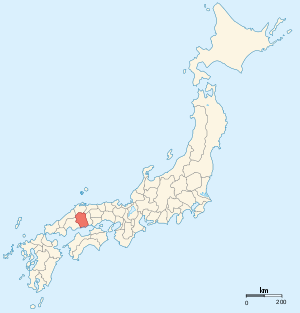
Bingo Province
Encyclopedia

Provinces of Japan
Before the modern prefecture system was established, the land of Japan was divided into tens of kuni , usually known in English as provinces. Each province was divided into gun ....
of Japan
Japan
Japan is an island nation in East Asia. Located in the Pacific Ocean, it lies to the east of the Sea of Japan, China, North Korea, South Korea and Russia, stretching from the Sea of Okhotsk in the north to the East China Sea and Taiwan in the south...
on the Inland Sea side of western Honshū
Honshu
is the largest island of Japan. The nation's main island, it is south of Hokkaido across the Tsugaru Strait, north of Shikoku across the Inland Sea, and northeast of Kyushu across the Kanmon Strait...
, comprising what is today the eastern part of Hiroshima Prefecture
Hiroshima Prefecture
is a prefecture of Japan located in the Chūgoku region on Honshu island. The capital is the city of Hiroshima.- History :The area around Hiroshima was formerly divided into Bingo Province and Aki Province. This location has been a center of trade and culture since the beginning of Japan's recorded...
. It was sometimes called , with Bizen
Bizen Province
was a province of Japan on the Inland Sea side of Honshū, in what is today the southeastern part of Okayama Prefecture. It was sometimes called , with Bitchu and Bingo Provinces. Bizen borders Mimasaka, Harima, and Bitchū Provinces....
and Bitchu
Bitchu Province
was a province of Japan on the Inland Sea side of western Honshū, in what is today western Okayama Prefecture. It was sometimes called , with Bizen and Bingo Provinces. Bitchu bordered Hōki, Mimasaka, Bizen, and Bingo Provinces....
Provinces. Bingo bordered Bitchū
Bitchu Province
was a province of Japan on the Inland Sea side of western Honshū, in what is today western Okayama Prefecture. It was sometimes called , with Bizen and Bingo Provinces. Bitchu bordered Hōki, Mimasaka, Bizen, and Bingo Provinces....
, Hōki
Hoki Province
was an old province of Japan in the area that is today the western part of Tottori Prefecture. It was sometimes called . Hōki bordered on Inaba, Mimasaka, Bitchū, Bingo, and Izumo Provinces....
, Izumo
Izumo Province
was an old province of Japan which today consists of the eastern part of Shimane Prefecture. It was sometimes called . The province is in the Chūgoku Region.- History :It was one of the regions of ancient Japan where major political powers arose...
, Iwami
Iwami Province
was an old province of Japan in the area that is today the western part of Shimane Prefecture. It was sometimes called . Iwami bordered Aki, Bingo, Izumo, Nagato, and Suō provinces.In the Heian era the capital was at modern-day Hamada....
, and Aki Province
Aki Province
or Geishū was a province in the Chūgoku Region of western Honshū, comprising the western part of what is today Hiroshima Prefecture.When Emperor Shōmu ordered two official temples for each province , two temples were founded in Aki Province...
s.
The ancient capital is believed to have been in the vicinity of Fuchu
Fuchu, Hiroshima (city)
is a city located in Hiroshima prefecture, Japan. It was originally the capital of the former Bingo Province.The city was founded on March 31, 1954...
. During the Sengoku Period
Sengoku period
The or Warring States period in Japanese history was a time of social upheaval, political intrigue, and nearly constant military conflict that lasted roughly from the middle of the 15th century to the beginning of the 17th century. The name "Sengoku" was adopted by Japanese historians in reference...
, Bingo was part of the Mori clan
Mori clan
The Mōri clan was a family of daimyō, descended from Ōe no Hiromoto and established themselves in Aki Province. Their name was derived from a shōen in Mōri, Aikō District, Sagami Province. The generation of Hiromoto began to name themselves Mōri.After the Jōkyū War, Mōri was appointed to the jitō...
domains, but after the Battle of Sekigahara
Battle of Sekigahara
The , popularly known as the , was a decisive battle on October 21, 1600 which cleared the path to the Shogunate for Tokugawa Ieyasu...
, Tokugawa Ieyasu
Tokugawa Ieyasu
was the founder and first shogun of the Tokugawa shogunate of Japan , which ruled from the Battle of Sekigahara in 1600 until the Meiji Restoration in 1868. Ieyasu seized power in 1600, received appointment as shogun in 1603, abdicated from office in 1605, but...
reassigned it to one of his allies.
A notable landmark includes the Fukuyama Castle
Fukuyama Castle (Bingo Province)
', sometimes called ' or ' was the castle of the Bingo-Fukuyama Han during the Edo period of Japanese history.The castle is located in Fukuyama Park in Fukuyama, Hiroshima near Fukuyama Station.-Overview:...
, which was the castle
Japanese castle
' were fortresses composed primarily of wood and stone. They evolved from the wooden stockades of earlier centuries, and came into their best-known form in the 16th century...
of the Bingo-Fukuyama Han
Han (Japan)
The or domain was the name of the estate belonging to a warrior in Japan after the 17th century. The fiefs of the daimyos of the samurai class of Japan during the Edo period were called han.-Edo period:...
during the Edo period
Edo period
The , or , is a division of Japanese history which was ruled by the shoguns of the Tokugawa family, running from 1603 to 1868. The political entity of this period was the Tokugawa shogunate....
of Japanese history
History of Japan
The history of Japan encompasses the history of the islands of Japan and the Japanese people, spanning the ancient history of the region to the modern history of Japan as a nation state. Following the last ice age, around 12,000 BC, the rich ecosystem of the Japanese Archipelago fostered human...
.

